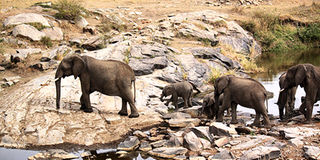Rains came too late for hundreds of wildlife

The growing sophistication in the weapons used by poachers has decimated the elephant population in the country by about 216 since 2007. Conservationists now warn that the world’s largest land mammal may become extinct if the trend persists. Photo/FILE
What you need to know:
- Now KWS takes steps to restore populations of animals in parks
The rains are finally here, heralding a new start for the agricultural masses. But welcome as they are, they came a bit too late for the country’s prime tourist attraction – the wildlife.
According to the Kenya Wildlife Services, hundreds of animals died solely due to the drought.
The country lost 40 of its 2,000 grevy’s zebra to the drought, which is two per cent of their population.
“Losing 40 is a significant loss,” said Mr Patrick Omondi, a KWS Senior Assistant Director.
Sustainable levels
The situation for hippos and elephants was even worse.
“The water level in the Mara River dropped below the minimum sustainable levels and we lost about 500 to 600 hippos,” Mr Omondi said.
In Tsavo, 150 elephants died from drought, most of which were calves and older adults that could not walk the long distances to the water sources.
Another 70 died in northern Kenya. “Our vets did analysis of the dead animals and their conclusion was that they had died from the drought; either from thirst or starvation,” Mr Omondi said.
While it was possible to supplement the hippo population’s food intake by supplying them with hay, the same was not possible for elephants because of the difference in their lifestyle and mobility.
“Hippos tend to stay all together in the water, making it easy to drop food for them, but the elephant’s terrain is so expansive it’s impossible to predict where they will be to leave food for them,” he said, adding that there were numerous offers of food donations for the elephants that they had to turn down.
Poachers have staked out the sporadic watering holes in northern Kenya and preyed on the slow moving elephants, killing 189 this year alone.
“That’s the highest number of elephants poached since the international ban on ivory sales in 1999,” Mr Omondi said. Another 98 were killed by poachers in 2008 and 46 in 2007.
It’s not only poachers, but also herders that are causing problems.
In many part of the country, “huge numbers” of livestock are being sneaked into conservation areas. With a lack of adequate grazing lands, many herders moved their animals into game reserves, a move that is not only illegal, but also disruptive to the natural balance of the parks.
“The cattle eat food that the wild game relies on; diseases can spread from domestic to wild animals, and the herders sometimes kill the animals that eat their cattle,” Mr Omondi said.
A total of 10 lions have been killed by herders who have lost their cattle to the large cats. In one case, farmers poisoned a carcass and it left for the lions. It killed not just a lion, but also 300 vultures that ate the carcasses of the cow and the lion.
Mr Omondi says the herders should expect to lose some of their animals if they choose to break the law and let them graze in game reserves.
The problem of livestock in game reserves was so serious, that the biggest expenditure of the KWS during the drought was in driving cattle out of the parks. In many cases helicopters had to be used at a cost of $1,000 (Sh75,000) per hour.
One of the challenges KWS faces in its efforts to keep cattle out of game reserves is that the Maasai Mara, Kenya’s most famous park, is not managed by the service. Instead, it’s managed by the Narok County Council who, Mr Omondi says, turn a blind eye to the herders.
“We have tried talking to the council to stop them, but it hasn’t worked,” he said.
As a response, the KWS is working on improving cattle grazing regulations. The wildlife service is also implementing new water management techniques to alleviate the effects of future droughts.
Conservation areas
“We’re looking into putting up ponds and water collection points in conservation areas,” Mr Omondi said.
The long-term effects of drought are well-known to KWS, and Mr Omondi points to the case of the wild buffalo populations as an example. Reducing in numbers from 12,000 in 1984 to about 4,000 today, the primary factor in the drop of wild buffalo numbers were the 1984 and 1993 droughts.
Even with the potential long-term effects and the short-term reduction in animal populations, KWS is optimistic about the future of Kenya’s wildlife.




